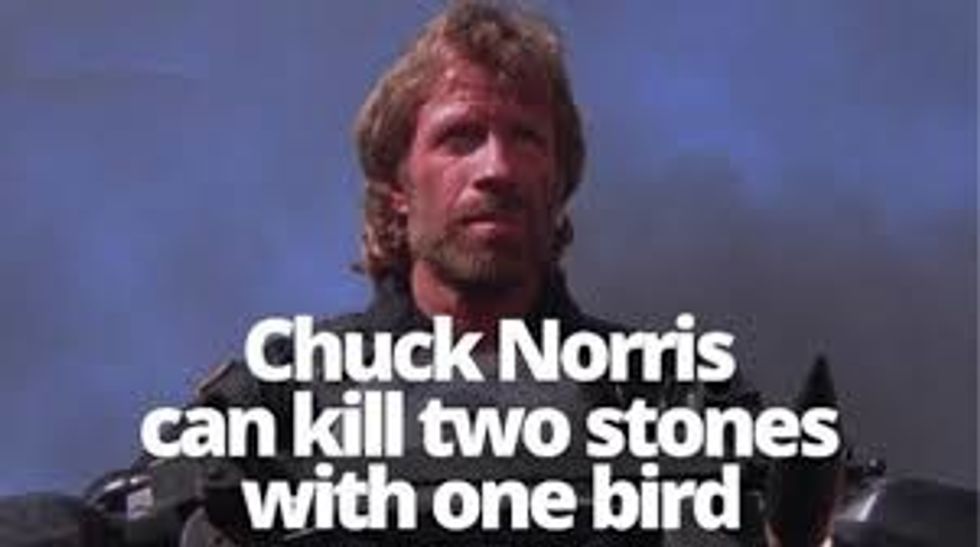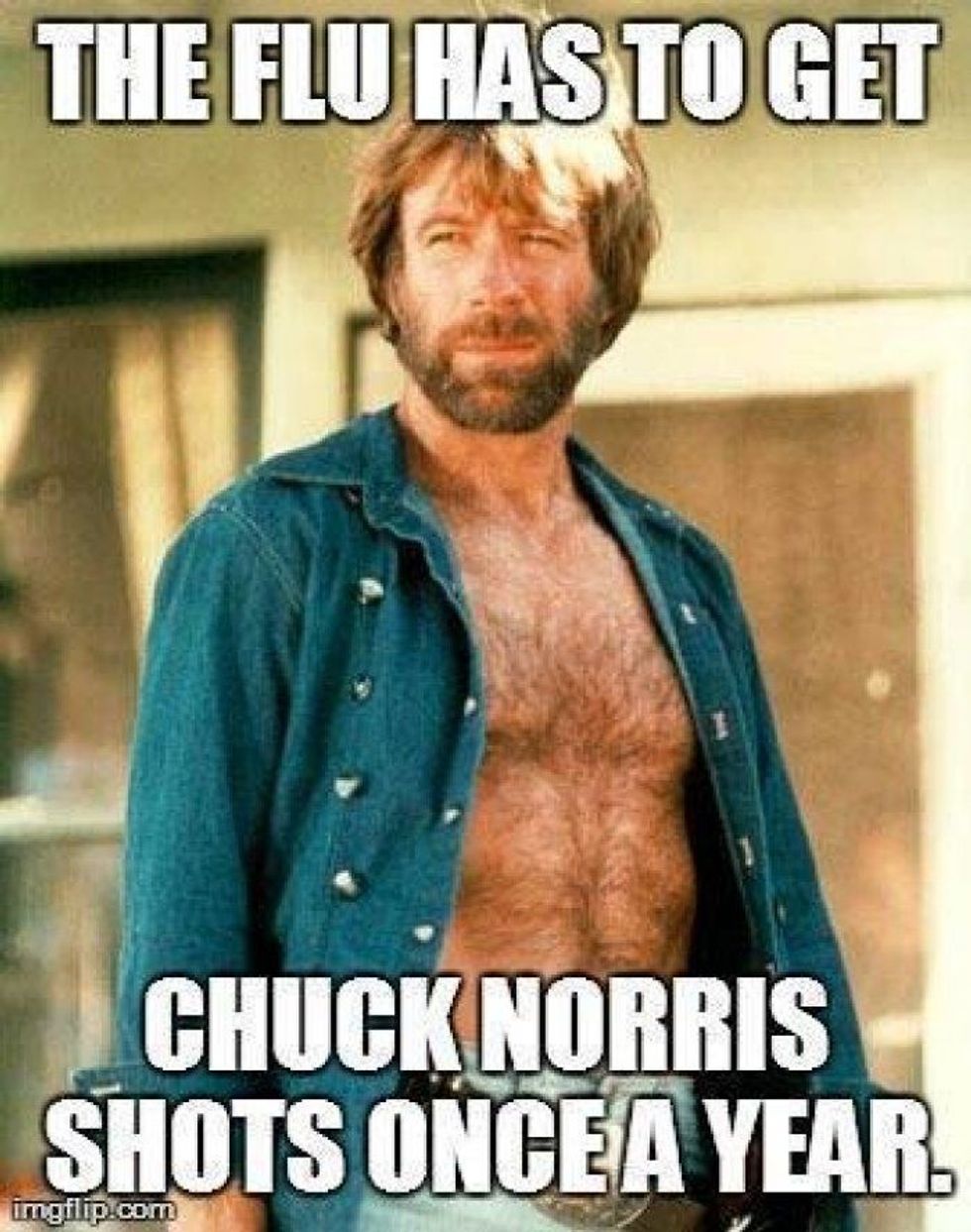
Chuck Norris - martial artist, actor, film producer, screenwriter
By Markus Wissmann (Shutterstock)
In days of Internet memes past, there was a name in constant circulation: Chuck Norris.
The memes about the action movie star all largely shared the same format: an image of Chuck Norris or a seemingly unrelated image and then copy that read something like, “Chuck Norris hit 11 out of 10 targets with nine bullets,” or “When Chuck Norris does a push up, he isn’t lifting himself up, he’s pushing the world down.”
Some of the memes even referenced world events, like this one that refers to a viral video of United Airlines forcibly removing a passenger who refused to give up his seat on an overbooked flight.
In the early 2000s these memes were, bizarrely, all the rage among millennials, most of whom had never seen a Chuck Norris movie or even heard of Walker, Texas Ranger. While the Internet has long since moved on from Chuck Norris memes, their pervasive presence during those bygone times when memes lasted for more than a few days has cemented Chuck Norris as a beloved figure in the hearts of a generation who wouldn’t otherwise know him.
Yesterday, on his 80th birthday, the Internet was flooded with a renaissance of Chuck Norris memes to celebrate the star.
It’s an excellent joke format that has broad enough rules to allow any interested participant to join in. Really, it’s less about Chuck Norris and his perceived toughness than it is about the fun puzzle of coming up with your own Chuck Norris joke and trying to one-up your friends. But one has to wonder, nearly two decades after they first started to appear, how did Chuck Norris memes start?
The History of the Chuck Norris Meme
It’s easy enough to pinpoint the beginning of the phenomenon simply by looking at Google trends.
It’s clear that 2004 saw a massive spike in searches for “Chuck Norris,” meaning that it’s safe to say 2004 was the birth year of the Chuck Norris meme. But why?
Many people across Internet forums think the emergence had to do with Conan O’Brien’s “Walker, Texas Ranger lever,” which first aired on the latenight talk show in 2004. The joke was that Conan had a lever under his desk, and whenever he pulled it a clip from the ’90s TV series (starring Chuck Norris, of course) played.
The lever was mainly an excuse for Conan to riff on the cheesiness of the show and the seemingly unbeatable masculine strength of Norris’ character, but nonetheless it gave a notable resurgence to the public’s awareness of the once popular TV show.
After that, things get murkier. According to one Quora user, during the summer of 2005, a thread was started on SomethingAwful.com that listed “Vin Diesel facts” in a very similar format to what would soon become the Chuck Norris joke format. As this thread grew in popularity, one user, a teenager named Ian Spector, made a web page called the “Vin Diesel Fact Generator” that offered a collection of the “facts” and allowed users to create their own. Soon, the website started to fall in popularity, which led Spector to ask for ideas for a replacement to Vin Diesel. As you can guess, Chuck Norris was the landslide winner and the “Vin Diesel Fact Generator” became the “Chuck Norris Fact Generator.”
According to Know Your Meme, “Eventually, the Chuck Norris Facts become extremely popular, finally forever surpassing Vin Diesel Facts in popularity.” From there, the format of these facts was so ingrained in Internet culture that the generator itself became secondary to the established format. To track the development of the meme beyond that point is more or less futile, given the chaotic nature of the Internet. But what we do know for sure is that fuel was added to the fire in 2011, when Chuck Norris himself got in on the joke.
If you refer back to the very scholarly and important Google chart, you can see the spike in searches related to Chuck Norris in 2011, likely thanks to this viral ad campaign.
The Impact of Chuck Norris Memes
We may never know for sure what it is about the “Chuck Norris Facts” joke that captured the Internet’s attention for so many years, but let’s assume a psychological perspective. If you’re an optimist, you might connect the memes to the slow death of toxic masculinity and see Chuck Norris facts as a way to mock and belittle the sort of masculine energy once so revered in our culture. We laugh at the ludicrous displays of violence and toughness in Walker, Texas Ranger because we recognize that manhood is about a lot more than physical prowess and machismo. Maybe Chuck Norris facts were such a phenomenon in 2004 because we were just beginning to recognize the toxicity that comes with the kind of hyper-masculinity that Chuck Norris represented.
But if you’re more cynical, you may connect Chuck Norris facts to just the opposite and see them as an obvious precursor to an online culture that would soon be filled with alt-right propaganda, anti-women chat rooms, incel groups, and other dark, hyper-masculine Internet spaces like 4chan. These polarizing bubbles would go on to breed school shooters and other white, male domestic terrorists, and it’s not a crazy leap to think that many of those men—back in 2004—may have enjoyed Chuck Norris facts as a kind of hero worship.
Chuck Norris, as a person, is inconsequential (despite how problematic he actually is); what’s more important is Chuck Norris, as a phenomenon and as a symbol. Though what exactly that symbol represents within the context of the chaos of the Internet depends on your own pre-existing biases and reveals more about how you see the world than you’d expect from a simple meme.
















